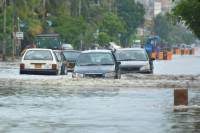
A new monsoon spell is expected to hit the country today (Thursday) bringing thunderstorms and heavy rain to different regions including Islamabad, Punjab, Sindh, Balochistan, Khyber Paktunkhwa, Gilgit-Baltistan and Kashmir.
According to Federal Climate Change Minister Sherry Rehman, this weather spell will prevail till July 17.
In a tweet, Rehman warned that low-lying areas in Islamabad, Peshawar, Rawalpindi, Gujranwala and Lahore would be at risk of urban flooding
Similarly, hillside stations such as Murree, Galiyat, Kashmir, Gilgit-Baltistan and Khyber-Pakhtunkhwa could potentially be hit by landslides.
“This monsoon spell is expected to continue until July 17…All relevant departments have been instructed to remain alert,” said the minister.
“Tourists to these regions are advised to exercise caution to avoid misadventures during this period. Strong winds, thunderstorms, and heavy rainfall can cause damage to vulnerable infrastructure such as power poles, solar panels, and mud houses. Therefore, citizens are requested to take necessary precautions,” she added.
Earlier this month, a severe monsoon spell left death and devasation in its wake, with floods, landslides and faulty infrastructure claiming the lives of at least 50 people. Moreover, 87 people were reportedly injured.
“Fifty deaths have been reported in different rain-related incidents all over Pakistan since the start of the monsoon on June 25,” a National Disaster Management Authority (NDMA) official had confirmed.
Officials in Lahore said that the country’s second-largest city had received record-breaking rainfall, turning roads into rivers and leaving almost 35% population without electricity and water.
The previous rain spell set in on July 3, beginning with heavy showers in upcountry areas. By July 5, at least seven people had been killed in the city with 291 millimetres of rainfall recorded.
Fatalities were also reported in Sheikhupura, Faisalabad, Jhang and Khushab districts.
The summer monsoon brings South Asia 70% to 80% of its annual rainfall between June and September every year.
It is vital for the livelihoods of millions of farmers and food security in a region of around two billion people. But it also brings landslides and floods. Despite fatalities increasing each year, successive governments appear to be caught off-guard each time leaving citizens to resort to ad hoc measures or halt regular life to ensure safety.
Last summer, unprecedented monsoon rains put a third of the country under water, damaging two million homes and killing more than 1,700 people.
Scientists said climate change was making seasonal rains heavier and more unpredictable.







